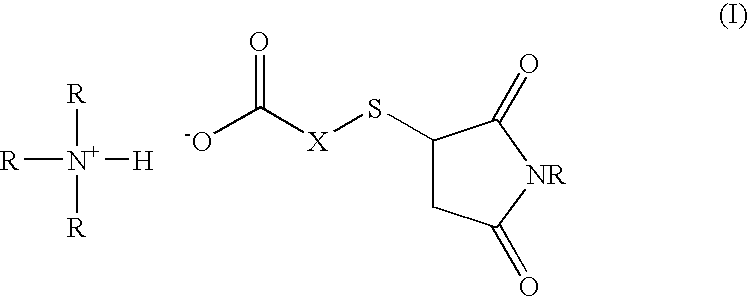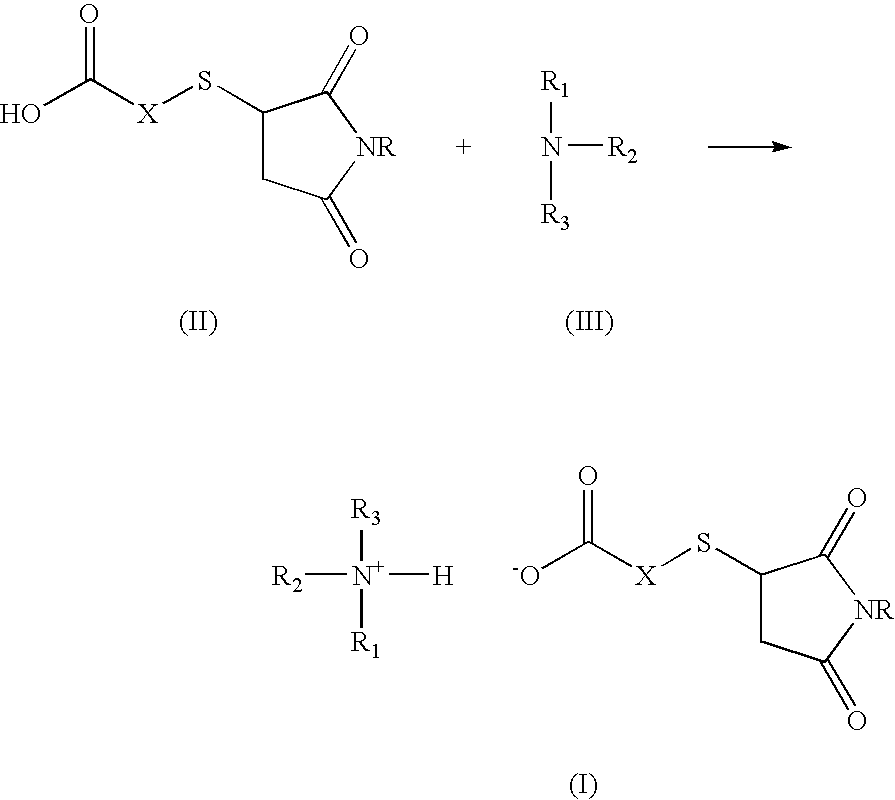Amine salt compound of carboxylic acid having thermal dissociation portion and compounding agent for rubber vulcanization and rubber composition containing the same
a technology of carboxylic acid and thermal dissociation portion, which is applied in the field of amine salt compound of a carboxylic acid containing thermal dissociation portion and a compounding agent for rubber vulcanization and a rubber composition containing the same, can solve the problems of slow vulcanization reaction compared, poor heat aging resistance, and difficulty in co-vulcanization with other diene-based rubbers, so as to achieve superior heat aging resistance and high vulcan
- Summary
- Abstract
- Description
- Claims
- Application Information
AI Technical Summary
Benefits of technology
Problems solved by technology
Method used
Image
Examples
preparation example 1
Synthesis of Compound 1
[0019]To 150 ml of methanol, 80 g (0.245 mol) of an N-substituted succinimide thio group-containing carboxylic acid and 27.9 ml (0.245 mol) of cyclohexyl amine were charged and the mixture was reacted at room temperature for 10 minutes. After the end of the reaction, the methanol was removed under a reduced pressure and the resultant mixture was filtered. The product was washed with acetone twice and dried, then was subjected to the reaction of the following formula to thereby obtain a white powder compound 1 in an amount of 103 g (yield 99%):
[0020]
[0021]1N NMR (400 MHz, DMSO-d6) δ in ppm: 1.0-1.3, 1.5, 1.7, 1.9, 2.7, 2.9, 4.6, 7.1, 7.2, 7.5
[0022]Elemental analysis value (%): C23H26N2O4S
[0023]Calculated (%) C, 66.77; H, 6.14; N, 6.57; O, 15.00; S, 7.52.
[0024]Found (%) C, 64.37; H, 5.86; N, 6.16; O, 15.82; S, 7.75.
preparation example 2
Synthesis of Compound 2
[0025]To 150 ml of methanol, 130 g (0.397 mol) of an N-substituted succinimide thio group-containing carboxylic acid and 41.5 ml (0.397 mol) of t-butyl amine were charged and reacted at room temperature for 10 minutes. After the end of the reaction, the methanol was removed under a reduced pressure and the resultant mixture was filtered. The product was washed with acetone twice and dried, then was subjected to the reaction of the following reaction scheme to thereby obtain a white powder compound 2 in an amount of 157 g (yield 99%).
[0026]
[0027]1H NMR (400 MHz, DMSO-d6) δ in ppm: 1.0-1.3, 1.5, 2.7, 2.9, 4.6, 7.1, 7.2, 7.5
[0028]Elemental analysis value (%): C23H26N2O4S
[0029]Calculated (%) C, 62.98; H, 6.04; N, 6.99; O, 15.98; S, 8.01.
[0030]Found (%) C, 62.44; H, 6.07; N, 6.77; O, 16.23; S, 8.14.
preparation example 3
Synthesis of Compound 3
[0031]In 150 g of methyl ethyl ketone, 15.4 g (0.1 mol) of thiosalicylic acid and 17.3 g (0.1 mol) of N-phenyl maleimide were reacted at 90° C. for 5 hours. After the end of the reaction, the reaction product was concentrated at 90° C. in vacuo to obtain a compound having the following formula in an amount of 32.5 g (yield 99%).
[0032]
PUM
| Property | Measurement | Unit |
|---|---|---|
| temperature | aaaaa | aaaaa |
| elongation | aaaaa | aaaaa |
| weight | aaaaa | aaaaa |
Abstract
Description
Claims
Application Information
 Login to View More
Login to View More - R&D
- Intellectual Property
- Life Sciences
- Materials
- Tech Scout
- Unparalleled Data Quality
- Higher Quality Content
- 60% Fewer Hallucinations
Browse by: Latest US Patents, China's latest patents, Technical Efficacy Thesaurus, Application Domain, Technology Topic, Popular Technical Reports.
© 2025 PatSnap. All rights reserved.Legal|Privacy policy|Modern Slavery Act Transparency Statement|Sitemap|About US| Contact US: help@patsnap.com



